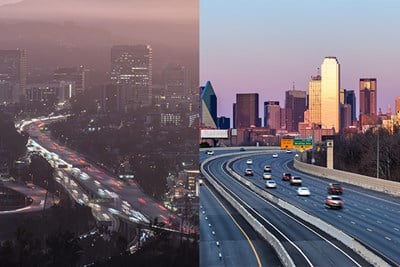Every day, new drivers take to the roads all across the United States. However, there are some places where young drivers are more common than others.
Today, we're taking a look at the states with the highest share of young drivers on the road and how different states approach educating and training these drivers.
North Carolina
North Carolina reports 205,106 drivers under the age of 19, navigating a state with specific rules designed for their safety. The state employs a Graduated Driver Licensing (GDL) program, a multi-stage process to help teens gain experience behind the wheel. This system starts with a limited learner permit, progresses to a limited provisional license, and finally leads to a full provisional license.
Key restrictions are in place to minimize risk. For the first six months, newly licensed drivers under 18 can only have one passenger under 21 who is not a family member. Additionally, supervised driving hours are required, and there are strict limitations on nighttime driving.
To further promote safety, North Carolina runs programs like the "Click It or Ticket" campaign, which emphasizes seat belt use among all drivers, including teens.
New Jersey
New Jersey is home to 207,917 drivers under the age of 19, all navigating some of the nation's busiest roads.
A key feature of New Jersey's GDL law is Kyleigh's Law. This measure requires all drivers under 21 with a permit or probationary license to display a red, reflective decal on their front and rear license plates. This simple identifier helps law enforcement spot GDL drivers and enforce specific restrictions, such as passenger limits and a curfew between 11:01 p.m. and 5:00 a.m.
Beyond licensing, the state promotes safety through initiatives like the New Jersey Teen Safe Driving Coalition. This group works to reduce teen driver crashes by raising awareness about issues like distracted driving and seat belt use.
South Carolina
South Carolina has 209,301 drivers under the age of 19 on its roads. They start with a beginner's permit, available at age 15, which requires supervision from a licensed adult.
After holding a permit for 180 days, teens can apply for a conditional license. This license comes with significant restrictions. Young drivers are prohibited from driving between midnight and 6 a.m. unless for work or school. For the first year, they are also limited to carrying no more than two passengers under the age of 21 who are not family members.
Alabama
Alabama has 213,616 drivers under the age of 19 navigating its roads. To manage this group, the state enforces a multi-stage Graduated Driver Licensing (GDL) law.
After obtaining a restricted license at age 16, young drivers face several key limitations. They are prohibited from driving between midnight and 6 a.m. unless traveling for specific reasons like work or a school event. Additionally, they are not allowed to have more than one non-family passenger in the vehicle. The use of any handheld communication device while driving is also strictly forbidden for this group.
Tennessee
Tennessee has 229,400 drivers under the age of 19 on its roadways.
Young drivers start with a learner permit before progressing to an intermediate license. During the intermediate phase, drivers face several key restrictions. They are prohibited from driving between 11 p.m. and 6 a.m. unless accompanied by a licensed parent or guardian. Additionally, for the first six months, they are limited to only one passenger under the age of 21.
Beyond licensing laws, Tennessee promotes teen driver safety through various initiatives. Programs like "Reduce TN Crashes" partner with high schools across the state to raise awareness about critical issues such as distracted driving, speeding, and seat belt use.
Minnesota
Minnesota has 241,635 drivers under the age of 19 on its roads. Under the state's GDL laws, drivers with a provisional license face specific restrictions for the first year. For the initial six months, they cannot drive between midnight and 5 a.m. unless supervised or traveling for work or school. During this period, they are also limited to one passenger under the age of 20 who is not an immediate family member. For the second six months, the passenger limit increases to three.
Pennsylvania
Pennsylvania has 289,096 drivers under the age of 19.
A significant part of Pennsylvania’s law is its passenger limitation. For the first six months with a junior license, a driver under 18 cannot have more than one unrelated passenger under 18. After six months, that number increases to three, though exceptions are made for family members. The state also enforces a curfew, prohibiting junior license holders from driving between 11 p.m. and 5 a.m.
To bolster these laws, Pennsylvania promotes safety through various outreach efforts. These programs often focus on the dangers of distracted driving, which is a leading cause of crashes among teens.
New York
New York State is home to 326,272 drivers under the age of 19, who must learn to navigate a wide range of driving environments, from busy city streets to rural roads.
The state’s GDL laws include strict regional rules. For example, in New York City, junior license holders are generally prohibited from driving. In other areas like Long Island, they are restricted from driving unsupervised between 9 p.m. and 5 a.m. Passenger rules also apply, limiting the number of non-family members under 21 in the vehicle.
Ohio
Ohio has approximately 330,793 drivers under the age of 19.
After getting a temporary instruction permit, teens can get a probationary driver's license. This license comes with important safety restrictions. For the first year, drivers under 18 are not allowed to drive between midnight and 5 a.m., unless for work, school, or a religious event. They also face passenger limits, initially restricting them to just one non-family member in the vehicle. Additionally, Ohio law prohibits any use of electronic devices, including hands-free devices, for drivers under 18.
To support these laws, Ohio promotes various teen safe driving programs. Initiatives like the "Drive to Excel" program reward teens for safe driving habits.
Michigan
With 332,815 drivers under the age of 19, Michigan presents a unique landscape for young people learning to drive. The state's weather, with its heavy snowfall and icy conditions, adds a layer of difficulty not found everywhere. To prepare for this, driver's education in Michigan includes specific training on handling adverse weather, a crucial skill for navigating local roads safely.
Michigan’s Graduated Driver Licensing (GDL) law is divided into three distinct levels. A notable part of this system is the requirement for Segment 2 of driver's education. After teens have driven for at least three months and logged 30 hours of practice, they must complete this second phase of classroom instruction, which focuses on defensive driving and risk awareness.
Georgia
With 339,095 drivers under the age of 19, Georgia has one of the largest populations of young drivers in the nation. To help them prepare for the road, the state has specific laws designed to build experience and reduce risk. One key piece of legislation is Joshua's Law, named in memory of Joshua Brown, a teen who died in a car crash.
This law has a few important requirements for teens wanting a license at age 16. They must complete an approved driver education course consisting of 30 hours of classroom instruction and six hours of on-the-road training. They also need to log 40 hours of supervised driving practice, including at least six hours at night.
Once licensed, teens face restrictions. A Class D license holder under 18 cannot drive between midnight and 5 a.m. For the first six months, they can only carry immediate family members as passengers.
Illinois
Illinois has 384,522 individuals under the age of 19 on its roads. The state’s Graduated Driver Licensing (GDL) program is designed to help them gain experience in a safe, controlled way. A unique part of this process is the strong emphasis on parental involvement. Parents or legal guardians must provide 50 hours of supervised practice, including 10 hours at night, and give their consent for a minor to get a license.
Florida
Florida has one of the largest young driver populations in the country, with 437,165 drivers under the age of 19. Helping them learn the rules of the road safely is a top priority, which is why the state has a Graduated Driver Licensing (GDL) program.
This program sets clear steps for teens. At 15, they can get a learner's license, which requires driving with a licensed adult. To move on to an intermediate license at age 16, they must complete 50 hours of supervised driving, with at least 10 of those hours happening at night. This nighttime driving practice is especially useful for handling Florida's busy roads after dark.
Texas
With 651,638 drivers under the age of 19, Texas has the second-largest population of young drivers in the United States. Navigating the state's vast and varied road systems, from crowded city highways to long rural routes, presents a unique challenge.
A standout feature of Texas law is the requirement for teens to complete an Impact Texas Teen Drivers (ITTD) course. This free, two-hour video course highlights the dangers of distracted driving and must be completed no more than 90 days before the driving skills test. It serves as a crucial final lesson before a teen gets their provisional license.
California
With 717,430 drivers under the age of 19, California has the largest and most diverse population of young drivers in the nation. To help them navigate the state’s complex and often congested roadways, California has a comprehensive Graduated Driver License (GDL) program.
California also enforces a strict ban on using any electronic communication device while driving for all drivers under 18. This combination of required education, passenger limits, and nighttime restrictions helps prepare young people for a lifetime of safe driving on California’s busy roads.



